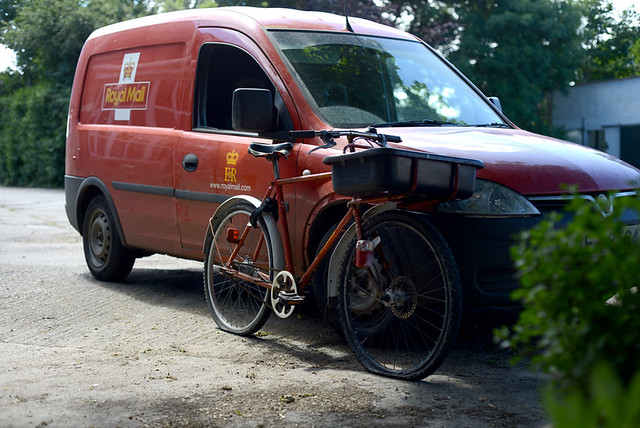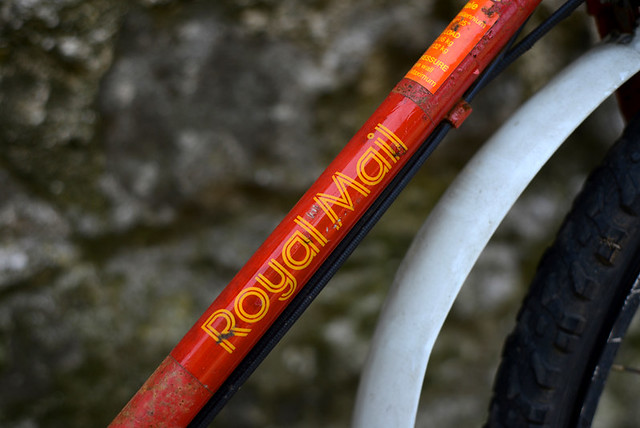When the postman stopped by with today's mail, I doubt he expected to find a two-wheeled ancestor of his delivery machine in my yard. Yet that is exactly what happened.
"Ever ridden one of these?" I asked.
He shook his head vigorously. "How old is this thing anyway?"
The machine - a rescue bike that found its way to me - is actually not very old by vintage bicycle standards. But its condition is rather dire - from the heavily rusted frame and components, to the missing original front wheel. Whether it can be revived I am not yet sure, but it is an interesting historical specimen regardless.
Since the late 1970's, Pashley Cycles have been the main supplier of bicycles for the Royal Mail, and it is only this year that the practice is ending. Over the decades, there have been several iterations of the Pashley Postal Bike, and the one in my possession is a "Millenium" model from the mid '90s.
The lugged diamond frame with a slight upslope to the top tube is built around 26" wheels with fat tires. A carrier rack bolts onto the lower and upper head lugs and holds the plastic mail delivery basket. At the time this bike was made, the Pashley postal bicycles came in "male" (says so on the decal) and "female" versions. Later these were replaced by the unisex welded MailStar model.
One thing I've wondered about the postal bikes, is why they did not use the smaller front wheel design, so that the basket and load capacity could be made larger. However, the 26" front wheel design seems to have been standard with UK postal bicycles, even before Pashley supplied them.
Until some time in the 1990s the postal bikes were built as single speeds with rod brakes. The Millennium model was introduced in response to the Royal Mail's request to improve the bike's handling and durability. At this time, the bikes were redesigned to have all-weather braking capacity, as well as to be sportier an more lightweight. Plastic mudguards, hub gears and brakes (3-speed SRAM - as Sturmey Archer was having production difficulties at the time), straight handlebars, and other small updates were introduced during this period while keeping the traditional lugged construction. In 2000 Pashley developed the altogether new welded unisex design, which they called the Pronto and the Royal Mail dubbed the MailStar, ending the era of the classic delivery bike.
Since the Millenium postal bikes were designed specifically to be hardy and survive all-weather conditions, the excessive wear on this one suggests that it was left outdoors in the rain for prolonged periods of time - possibly after its life as a postal bike had come to an end.
I am told a few people around here used to own decommissioned postal bikes and use them as farm bikes and pub bikes. Seems pretty consistent with the state this one is in.
Too bad, as it could have been a lovely surviving example of the mail-by-bike era, as well as of the classic delivery bike.
If I can get it ridable, I would love to know what this bicycle feels like on the road - especially with the amount of weight a postman would typically carry. Assuming the frame has not rusted through, as far as functionality the bike requires a new front wheel, new tires, new saddle, possibly new handlebars, and a front brake system.
But everyone who's cast their eyes on it so far has suggested restoring it from scratch - sandblasting and respraying the frame, sourcing period-appropriate decals, and so forth. It is an excellent idea (and Pashley is willing to help, judging by the conversation I've just had with them). And though I am not sure I am the right person for such a daunting project, I'll try to find someone who's into it, and see what can be done with this bicycle.
The era of the postal bike may be ending in the UK. But, according to Pashley, the Royal Mail operated the largest carrier bike fleet in the World - and so, for a while at least, the postal bikes from decades past will find their way into civilian use, both local and distant. And in various states of alteration and refurbishment, the bikes will live on and ride on, their baskets filled with groceries, work bags and supplies, sometimes even with letters and parcels.












Tidak ada komentar:
Posting Komentar